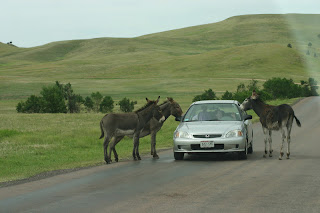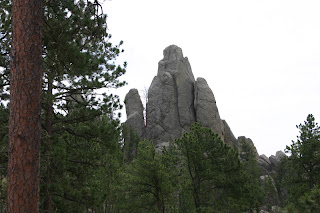There were once millions of bison but by 1900 it is estimated that fewer than 1000 bison remained on the entire continent. Peter Norbeck, often known as the "Father of Custer State park" recognized the situation and decided to take action to preserve the bison. In 1914, the park purchased 36 bison to start its herd. By 1940 the herd swelled to over 2500. Each year there are scheduled round ups to adjust the size of the herd based on the amount of grassland.
The pronghorn commonly referred to as antelope because of their similar appearance. The name pronghorn comes from the bucks large pronged horns. The fastest land animal in North America, pronghorns can run 60 mph for great distance.
The burros in Custer State Park are not native to the Black Hills. They are decedents from the herd that once hauled visitors to the top of Harney Peak. The rides were discontinued years ago and the burros were released in the park. Through the years , visitors have stopped to pet the burros and to take pictures (some people feed them)
Prairie dogs are found on the dry, upland prairie. It is a rodent that lives in large social groups called towns. The round mound of dirt that surrounds the prairie dog hole keeps the rain water out and from running into the burrow and serves as a observation post to watch for danger.
South Dakota's original bighorn sheep was the Audubon subspecies. When it became extinct about 1932, a herd of Rocky Mountain bighorn sheep were introduced to Custer State park.
Custer State Park has about 50,000 acres of what is considered forested, however wildfires have affected approximately 23,000 acres. The park consist of ponderosa pine, black hills spruce and junipers.
Iron Mountain Road, the winding road runs between Mt Rushmore National Memorial and junction 16A and SD36. Constructed in 1933 only portions of the road were within the park, however was a must see. Black hills scenery pigtail bridges and tunnels that frame Mt Rushmore.
Peter Norbeck Scenic Byway complements the park's three scenic drives and includes some of the most dramatic natural and historic features in the Black Hills. Sites include the Needles, Mt Rushmore and a birds eye view of rocky peaks and forest hills of the Black Hills National Forest.





























No comments:
Post a Comment